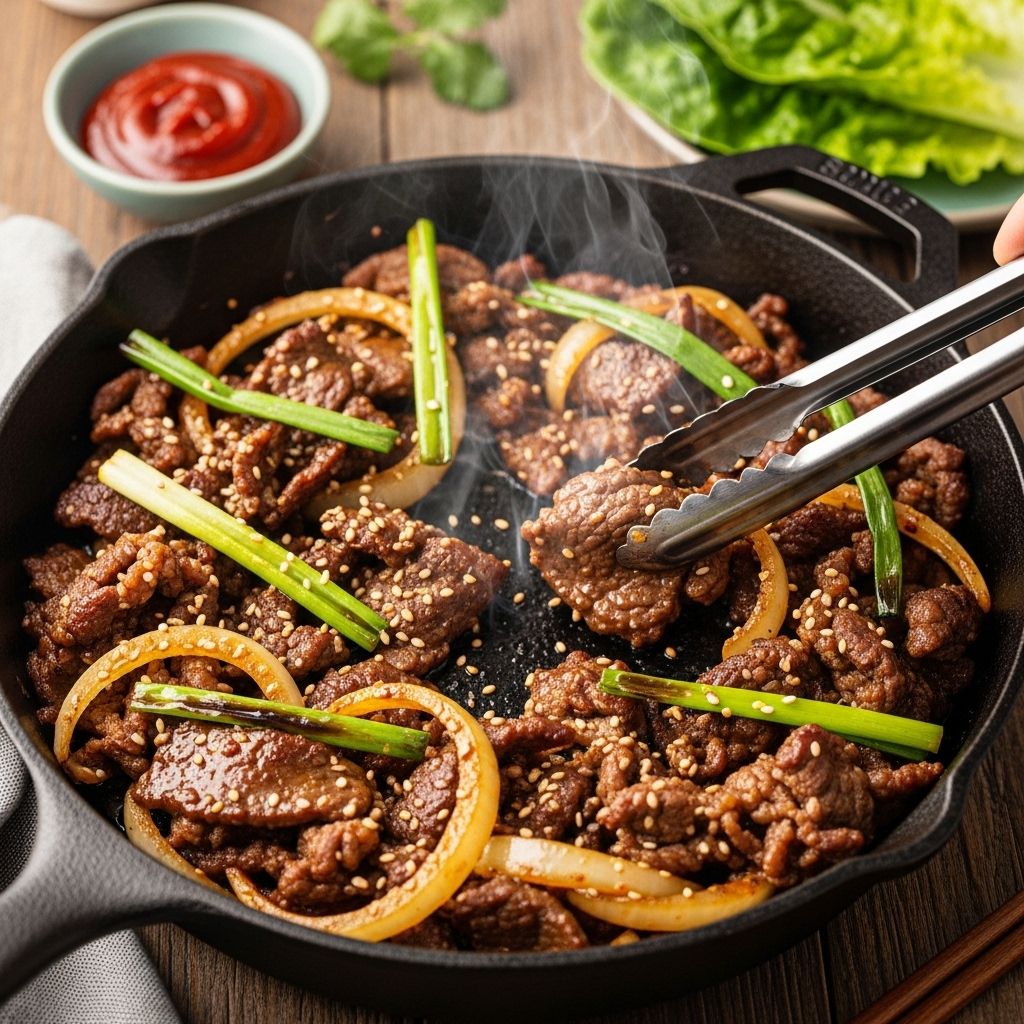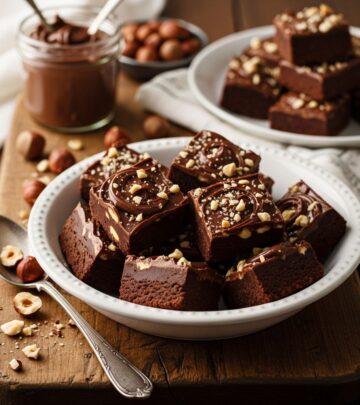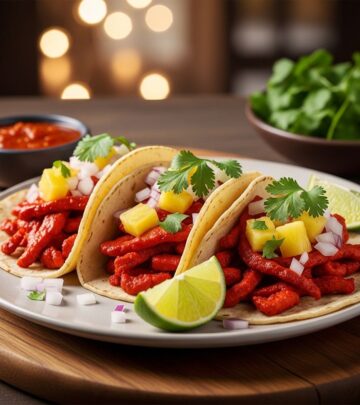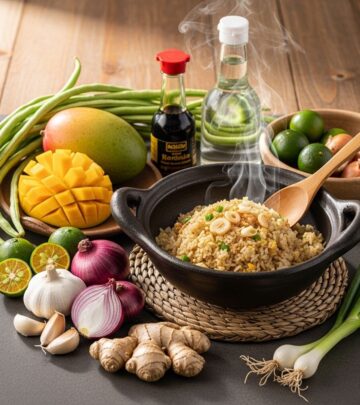Bulgogi Recipe: 4 Easy Steps For Authentic Korean BBQ Beef
Master the art of making restaurant-quality Korean BBQ beef in your own kitchen

Image: HearthJunction Design Team
Easy Bulgogi: Authentic Korean BBQ Beef Recipe
Bulgogi, which literally means ‘fire meat’ in Korean, is one of the most beloved dishes in Korean cuisine. This delicious preparation features thinly sliced beef that’s been marinated in a sweet and savory sauce, then quickly cooked to perfection. Our easy bulgogi recipe brings authentic Korean flavors right to your kitchen, requiring minimal preparation while delivering maximum flavor. The beauty of this dish lies in its versatility – it’s perfect for weeknight dinners yet impressive enough for special occasions.
What makes this bulgogi recipe stand out is its perfect balance of flavors. The marinade combines the umami richness of soy sauce with the nutty warmth of sesame oil, while garlic and ginger add aromatic depth. A touch of sweetness from sugar and honey helps to caramelize the meat during cooking, creating those characteristically delicious charred edges that bulgogi is famous for.
Unlike some traditional recipes that might require specialized ingredients or equipment, this version is designed to be accessible for home cooks using readily available ingredients. The thin slices of sirloin steak cook quickly, making this an ideal recipe even for busy weeknights when you’re craving something flavorful and satisfying.
What is Bulgogi?
Bulgogi is a classic Korean dish that has gained international popularity for its irresistible flavor profile. Traditionally, it consists of thinly sliced beef that’s been marinated in a mixture of soy sauce, sugar, sesame oil, garlic, and other seasonings before being grilled or pan-fried. The name itself reveals its cooking method – ‘bul’ means fire and ‘gogi’ means meat in Korean, referring to the traditional method of cooking the marinated meat over an open flame.
While the dish has ancient origins dating back to the Goguryeo era (37 BCE–668 CE), modern bulgogi as we know it today became popular during the 20th century. What makes bulgogi special is not just its flavor but its cultural significance – it’s often served at celebrations and gatherings, symbolizing prosperity and the bringing together of family and friends.
This easy bulgogi recipe stays true to the dish’s traditional flavors while adapting the preparation methods for modern home cooking. Instead of requiring a specialized Korean barbecue grill, this version can be prepared in a standard wok or skillet, making it accessible for everyday cooking.
Why You’ll Love This Recipe
There are countless reasons why this bulgogi recipe deserves a permanent spot in your cooking rotation:
- Quick preparation: While the meat benefits from marinating, the active cooking time is just about 5 minutes.
- Versatile serving options: Serve it with rice, in lettuce wraps, or as part of a larger Korean-inspired spread.
- Balanced flavors: The perfect combination of sweet, savory, and umami elements creates a complex yet harmonious taste.
- No special equipment needed: Unlike traditional bulgogi that might require a specialized grill, this recipe uses a standard wok or skillet.
- Customizable heat level: Adjust the Korean red pepper flakes to suit your spice preference.
Another fantastic aspect of this recipe is that it uses sirloin steak that’s sliced thin enough that no additional tenderization is necessary. The marinade does all the work of infusing flavor while also helping to ensure the meat remains tender during the quick cooking process.
Ingredients for Easy Bulgogi
This bulgogi recipe calls for simple ingredients that create complex flavors when combined. Here’s what you’ll need to gather before starting:
For the Marinade:
- ⅓ cup soy sauce – Provides the savory base and salt element
- 2 green onions, chopped (separating dark green parts from white and light green parts) – Adds fresh, mild onion flavor
- ¼ yellow onion, thinly sliced – Creates sweetness when cooked
- 3 tablespoons white sugar – Balances the savory elements and helps with caramelization
- 3 cloves garlic, minced – Essential for authentic Korean flavor
- 2 tablespoons toasted sesame seeds – Provides nuttiness and texture
- 1 tablespoon sesame oil – Adds rich, aromatic flavor
- ¼ teaspoon Korean red pepper flakes – Brings mild heat and color
- ¼ teaspoon minced fresh ginger – Adds warmth and aromatic notes
- ⅛ teaspoon ground black pepper – Enhances overall flavor
For the Beef:
- 1 ½ pounds beef sirloin steak, cut very thin using kitchen shears – The main protein
- 1 teaspoon honey, or to taste – Added during cooking for extra caramelization
The quality of your ingredients will significantly impact the final dish. For the best results, use fresh garlic and ginger rather than pre-minced versions. When selecting your beef, look for well-marbled sirloin steak, which will remain tender and flavorful during the quick cooking process.
How to Make Easy Bulgogi
Creating restaurant-quality bulgogi at home is surprisingly straightforward. Follow these simple steps for perfect results every time:
Step 1: Prepare the Marinade
In a large glass or ceramic bowl, whisk together the soy sauce, the white and light green parts of the green onions, yellow onion, sugar, minced garlic, toasted sesame seeds, sesame oil, Korean red pepper flakes, minced ginger, and black pepper. This creates the flavorful base that will infuse the beef with classic bulgogi taste.
Step 2: Marinate the Beef
Add the thinly sliced steak to the marinade and toss until each piece is evenly coated. For best results, cover the bowl with plastic wrap and refrigerate for at least 1 hour. If you have time, marinating for up to 24 hours will intensify the flavors even more. The marinade works to not only flavor the meat but also tenderize it slightly.
Step 3: Cook the Bulgogi
Heat a wok or large skillet over medium heat. The wide surface area allows for more meat to cook at once without overcrowding. Working in batches to avoid overcrowding the pan (which would cause the meat to steam rather than sear), cook and stir the steak along with its marinade. During cooking, add the honey to help caramelize the meat, creating those characteristic sweet, charred edges. Each batch should take about 5 minutes to cook through.
Step 4: Garnish and Serve
Once cooked, garnish the bulgogi with the reserved dark green parts of the green onions for a fresh finish. Serve immediately while hot for the best flavor and texture experience.
Serving Suggestions
Traditional Korean meals are known for their variety of dishes served simultaneously, and bulgogi works beautifully as part of such a spread. Here are some delicious ways to enjoy your homemade bulgogi:
- Classic rice bowl: Serve the bulgogi over a bed of steamed white rice for a simple, satisfying meal.
- Ssam style: Offer lettuce leaves on the side for wrapping the meat, along with ssamjang (a spicy paste) for an interactive dining experience.
- With banchan: Accompany with traditional Korean side dishes like kimchi, pickled vegetables, or spinach namul.
- Fusion style: Use the bulgogi as a filling for tacos, sandwiches, or even pizza for a Korean-inspired twist on familiar favorites.
For an authentic Korean meal experience, consider serving your bulgogi with a side of kimchi, which provides a perfect spicy and tangy contrast to the sweet and savory beef. A bowl of clear soup, such as doenjang jjigae (soybean paste soup) or a simple vegetable broth, also makes an excellent accompaniment.
Storage and Reheating Tips
If you’re lucky enough to have leftover bulgogi (though this is rarely the case!), here’s how to store and reheat it properly:
- Refrigeration: Store cooled leftover bulgogi in an airtight container in the refrigerator for up to 3 days.
- Freezing: For longer storage, bulgogi freezes well for up to 3 months. Portion it before freezing for easier reheating.
- Reheating: For best results, reheat in a skillet over medium heat just until warmed through. Avoid overcooking, as this can make the meat tough.
The flavors of bulgogi often deepen and meld together when left overnight, making next-day bulgogi particularly delicious. Consider making a double batch specifically to have leftovers for quick meals later in the week.
Recipe Variations
While this easy bulgogi recipe is delicious as written, there are several variations you might want to try:
- Fruit-enhanced marinade: Add grated Asian pear or apple to the marinade for natural sweetness and tenderizing enzymes.
- Spicy bulgogi: Increase the amount of Korean red pepper flakes for a spicier version.
- Vegetable bulgogi: Add sliced mushrooms, bell peppers, or carrots during cooking for added nutrition and texture.
- Chicken or pork bulgogi: Substitute thinly sliced chicken breast or pork loin for the beef.
For those seeking a more traditional authenticity, try using ribeye instead of sirloin and include grated Asian pear in the marinade, which is a classic ingredient in many traditional bulgogi recipes.
Frequently Asked Questions
Q: What is the best cut of beef for bulgogi?
A: While this recipe uses sirloin steak, other excellent cuts for bulgogi include ribeye, top round, or brisket. The key is to slice the meat very thinly across the grain for maximum tenderness.
Q: How thin should I slice the beef?
A: Aim for slices about 1/8-inch thick. Partially freezing the meat for 20-30 minutes before slicing makes it easier to achieve these thin cuts.
Q: Can I make bulgogi without a wok?
A: Absolutely! Any large skillet or frying pan will work well. Cast iron is particularly good for achieving nice caramelization.
Q: What are Korean red pepper flakes (gochugaru) and where can I find them?
A: Gochugaru are coarsely ground Korean chili flakes with a mild to medium heat level. They’re available at Asian grocery stores or online. In a pinch, you can substitute with a mix of regular red pepper flakes and sweet paprika.
Q: Is bulgogi always spicy?
A: Traditional bulgogi is actually mild and focuses more on sweet and savory flavors rather than heat. This recipe includes just a small amount of red pepper flakes for depth of flavor, not significant spiciness.
Nutritional Information
This easy bulgogi recipe creates a dish that’s not only delicious but also provides a good balance of nutrients. Each serving contains a generous amount of protein from the beef, along with essential minerals like iron and zinc. The sesame seeds add a small amount of healthy fats and calcium.
While traditional bulgogi does contain sugar in the marinade, the amount per serving is relatively modest. For those monitoring their sugar intake, the sweet element can be reduced or partially substituted with alternatives like grated apple or pear, which provide natural sweetness along with additional nutrients.
For a more balanced meal, serve the bulgogi with a variety of vegetable side dishes, which is the traditional Korean approach to creating nutritionally complete meals.
Conclusion
Bulgogi is one of those magical dishes that manages to be both exotic and comforting at the same time. This easy recipe brings the beloved Korean classic into your kitchen in an approachable way, without sacrificing authentic flavor. The combination of tender beef, sweet and savory marinade, and quick cooking method results in a dish that will quickly become a family favorite.
Whether you’re new to Korean cuisine or a longtime fan, this bulgogi recipe offers a delicious entry point into the rich culinary traditions of Korea. Customize it to your preferences, pair it with your favorite sides, and enjoy this globally beloved dish in the comfort of your own home.
From quick weeknight dinners to special gatherings with friends and family, bulgogi has the versatility and appeal to shine in any context. Master this recipe, and you’ll have an impressive, crowd-pleasing dish in your cooking repertoire that’s sure to generate requests for seconds – and for the recipe!
References
- https://www.allrecipes.com/recipe/246172/easy-bulgogi-korean-bbq-beef/
- https://www.allrecipes.com/recipe/100606/beef-bulgogi/
- https://www.allrecipes.com/recipe/255591/bulgogi-beef-korean-style-barbecue/
- https://www.allrecipes.com/recipe/63911/bulgogi-korean-barbecued-beef/
- https://www.allrecipes.com/recipes/17835/world-cuisine/asian/korean/main-dishes/bulgogi/
Read full bio of Srija Burman












